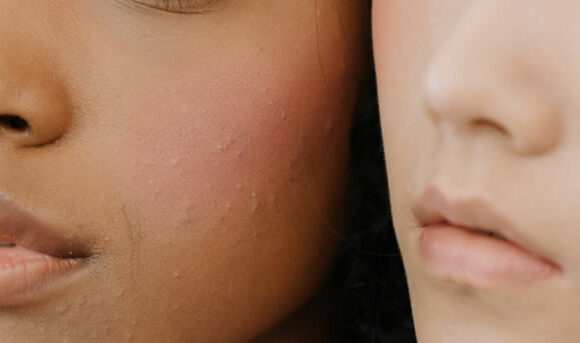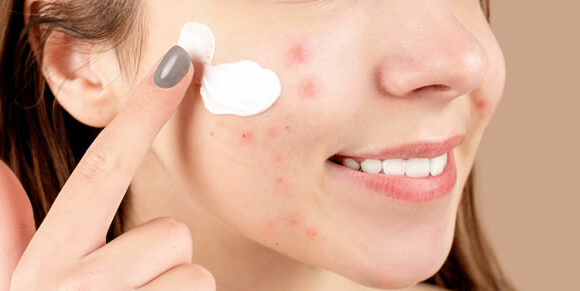Table Of Contents
- 1 Defining Fungal Acne
- 2 Causes Of Fungal Acne
- 3 Defining Bacterial Acne
- 4 Defining Bacterial Acne
- 5 Treatment Approaches For Fungal Acne And Bacterial Acne
- 6 Common Factors Influencing The Development Of Both Fungal And Bacterial Acne
- 7 Maintaining A Healthy Skincare Routine
- 8 Home Remedies And Acne Treatment
- 9 Conclusion
Acne is a common skin condition that manifests in various forms and has diverse underlying causes. These types of fungal and bacterial acne are often confused due to their similar appearance.
However, it is crucial to recognize that they are distinct conditions with different causes and treatment approaches. This comprehensive article will delve into the differences between fungal and bacterial acne, shedding light on their unique characteristics and providing effective treatment methods.
By understanding these conditions, individuals can make informed decisions regarding their skincare and seek appropriate remedies for their specific acne concerns.
Defining Fungal Acne

Fungal acne, also called Malassezia folliculitis or pityrosporum folliculitis, is a specific type of acne triggered by an overgrowth of yeast on the skin’s surface.
Despite its name, fungal acne is not synonymous with the more common bacterial acne called acne vulgaris. Excessive yeast production within hair follicles can result in fungal acne, leading to distinct symptoms and requiring specialized treatment.
Read our previous article to learn more about fungal acne.
Causes Of Fungal Acne
By exploring the following causes, we can gain a deeper understanding of the underlying factors that contribute to the emergence of fungal acne:
- Yeast Overgrowth in Hair Follicles: Fungal acne develops when an overgrowth of a specific fungus called Malassezia is within the hair follicles. This overabundance disrupts the natural balance of microorganisms on the skin, resulting in fungal acne breakouts.
- Moist Environments and Excess Oil Production: Fungal acne thrives in moist environments, such as those caused by excessive sweating, as well as in tropical climates and areas with high humidity. The combination of sweat and heat creates an ideal breeding ground for this yeast, facilitating the emergence of fungal acne.
- Impaired Immune System: An impaired immune system can contribute to fungal acne by allowing an overgrowth of yeast, such as Malassezia, in the hair follicles as the body is less able to fight off infections.
Defining Bacterial Acne

Bacterial acne, also known as acne vulgaris, is the more prevalent type of acne that most people are familiar with. Unlike fungal acne, bacterial acne primarily occurs due to the overgrowth of bacteria within the hair follicles.
The most common bacterial organism associated with acne vulgaris is Cutibacterium acnes (previously Propionibacterium acnes). This bacterium thrives in the skin’s hair follicles, especially in individuals with oily skin, and contributes to the formation of acne bumps.
Learn how to combat fungal acne on your back with our informative article.
Defining Bacterial Acne
By addressing the following causes, we can better understand the factors contributing to the development of bacterial acne:
- The proliferation of Acne-Causing Bacteria: Bacterial acne occurs when bacteria that are known to cause acne, such as Cutibacterium acnes, multiply excessively within the hair follicles. This bacterial overgrowth triggers inflammation and the subsequent development of acne bumps on the skin.
- Sebum Production and Clogged Follicles: The hair follicles can become clogged due to the overproduction of sebum, which is common in people with oily skin. Combined with acne-causing bacteria, this creates a favorable environment for bacterial acne breakouts.
- Hormonal Fluctuations: Hormonal imbalances, especially during puberty, menstrual cycles, pregnancy, or menopause, can increase sebum production and stimulate the growth of acne-causing bacteria like Cutibacterium acnes(C.acnes).
Treatment Approaches For Fungal Acne And Bacterial Acne
Below, we have outlined efficient treatment approaches for problematic fungal and bacterial organisms of the skin:
For Fungal Acne
To effectively treat fungal acne, addressing the underlying yeast overgrowth is crucial. The following treatment approaches are commonly used:
- 1. Topical Antifungal Treatments: Applying topical antifungal creams or lotions containing active ingredients like ketoconazole or ciclopirox directly to the affected areas can help eliminate the excess yeast and treat fungal acne effectively.
- 2. Oral Antifungal Medication: In more severe or persistent cases of fungal acne, a dermatologist may prescribe oral antifungal medication to combat the overgrowth of yeast and promote healing.
Moreover, we have written a detailed blog post about fungal acne treatment.
For Bacterial Acne
Treating bacterial acne involves targeting the acne-causing bacteria and reducing inflammation. The following approaches are commonly used:
- 1. Over-the-Counter Treatments: Over-the-counter treatments containing benzoyl peroxide, mandelic acid, or salicylic acid can effectively kill acne-causing bacteria and unclog pores, reducing bacterial acne breakouts.
- 2. Oral Medications: In cases of severe bacterial acne, a board-certified dermatologist may recommend oral medications, such as antibiotics or isotretinoin, to address the underlying bacterial overgrowth and minimize acne breakouts.
Common Factors Influencing The Development Of Both Fungal And Bacterial Acne
Several factors contribute to the development of both fungal and bacterial acne. These factors include:
- Hormonal Imbalances: Fluctuations in hormone levels, such as those experienced during puberty or due to hormonal disorders, can contribute to acne, including both fungal and bacterial acne.
- Increased Sebum Production and Clogged Pores: Excessive sebum production and the accumulation of dead skin cells can clog the hair follicles, creating an environment conducive to the development of acne.
- Genetic Predisposition: In some cases, individuals may have a genetic predisposition to developing acne, including fungal and bacterial acne. Certain genetic factors can affect the skin’s response to hormonal imbalances, excess oil production, and the presence of pathogenic microorganisms, making them more susceptible to acne breakouts.
- Lifestyle Factors: Various lifestyle factors, such as stress, poor diet, lack of sleep, and inadequate skincare routines, can impact the likelihood of acne formation.
Maintaining A Healthy Skincare Routine
Establishing and maintaining a consistent skincare routine is crucial for managing and preventing fungal and bacterial acne. Consider the following tips:
1. Gentle Cleansing And Exfoliation
Use mild cleansers and exfoliants to remove excess oil, dead skin cells, and impurities from the skin. Products containing salicylic acid and mandelic acid can be beneficial in unclogging pores.
2. Incorporating Effective Acne Treatments
Integrate effective acne treatments, such as products containing benzoyl peroxide or salicylic acid, into your skincare routine to eliminate acne-causing bacteria and promote clear skin.
Home Remedies And Acne Treatment
While various home remedies like tea tree oil or apple cider vinegar are often suggested for acne treatment, their effectiveness varies. It is important to note that home remedies may not yield similar results to clinically-proven treatments.
Consulting a dermatologist is recommended for an accurate diagnosis and adopting a practical treatment approach.
Moreover, we have also written an article about Malezia skincare, a game changer for acne and fungal acne.
Conclusion

In conclusion, fungal and bacterial acne are distinct conditions with different causes and treatment requirements. While they may exhibit similar appearances, understanding their underlying factors and seeking appropriate treatments is crucial for effectively managing and preventing breakouts.
Consulting a board-certified dermatologist and maintaining a consistent skincare routine are critical steps toward achieving clear, healthy skin.
By implementing the appropriate treatment approaches and adopting a proactive approach to skincare, individuals can effectively combat fungal and bacterial acne, ultimately enjoying improved skin health and enhanced self-confidence.
Moreover, you should also read our article about the top 32 fungal acne-safe toners your skin will love.
- Adamski Z, Gornowicz-Porowska J, Sobkowska D, Kaszuba K, Czajkowski R. Acne – therapeutic challenges to the cooperation between a dermatologist and a cosmetologist. Postepy Dermatol Alergol. 2021 Feb;38(2):21-31. doi: 10.5114/ada.2021.104273. Epub 2021 Mar 10. PMID: 34408562; PMCID: PMC8362767.
- Matin T, Goodman MB. Benzoyl Peroxide. [Updated 2022 Oct 10]. In: StatPearls [Internet]. Treasure Island (FL): StatPearls Publishing; 2023 Jan-. Available from: https://www.ncbi.nlm.nih.gov/books/NBK537220/
- Adamski Z, Gornowicz-Porowska J, Sobkowska D, Kaszuba K, Czajkowski R. Acne – therapeutic challenges to the cooperation between a dermatologist and a cosmetologist. Postepy Dermatol Alergol. 2021 Feb;38(2):21-31. doi: 10.5114/ada.2021.104273. Epub 2021 Mar 10. PMID: 34408562; PMCID: PMC8362767.
- Green M, Feschuk AM, Kashetsky N, Maibach HI. Clinical characteristics and treatment outcomes of Pityrosporum folliculitis in immunocompetent patients. Arch Dermatol Res. 2022 Dec 14:1–13. doi: 10.1007/s00403-022-02506-0. Epub ahead of print. PMID: 36517586; PMCID: PMC9750048.
- Sonthalia S, Agrawal M, Sehgal VN. Topical Ciclopirox Olamine 1%: Revisiting a Unique Antifungal. Indian Dermatol Online J. 2019 Jul-Aug;10(4):481-485. doi: 10.4103/idoj.IDOJ_29_19. PMID: 31334080; PMCID: PMC6615394.
